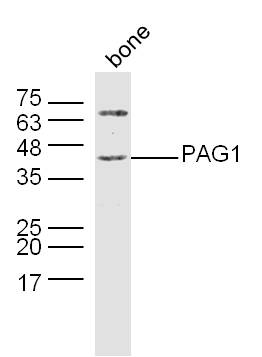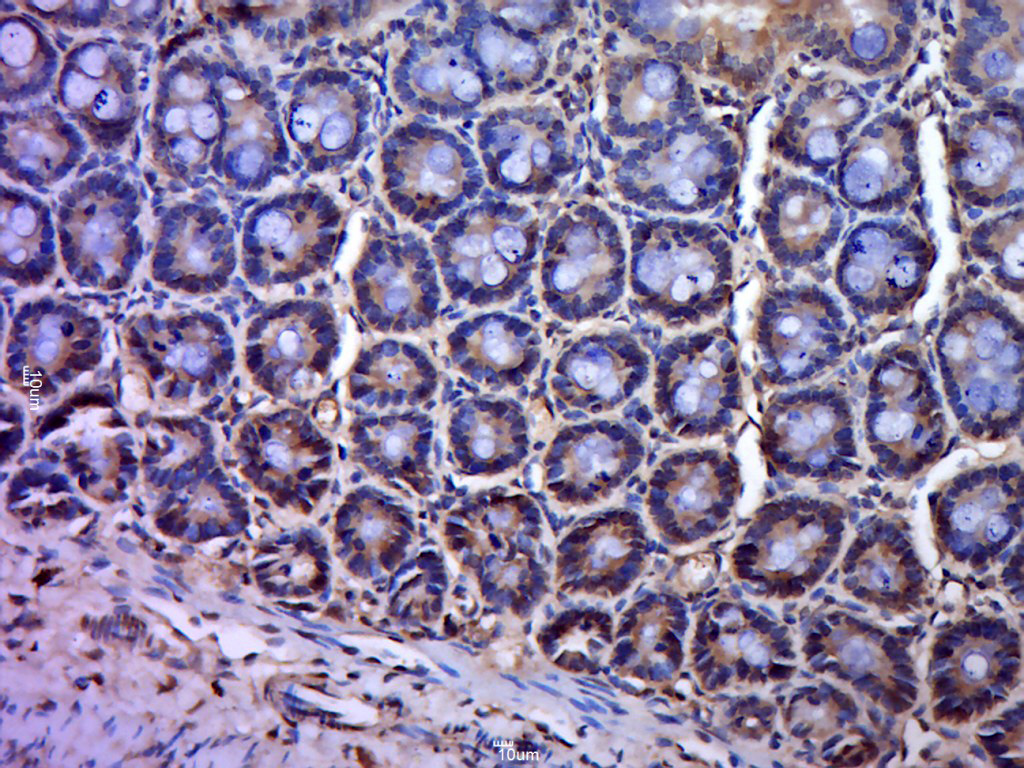
Rabbit Anti-PAG1 antibody
CBP; Csk Binding Protein; Csk-binding protein; FLJ37858; MGC138364; PAG 1; PAG; PAG1; PAG1_HUMAN; Phosphoprotein associated with glycosphingolipid enriched microdomains 1; Phosphoprotein associated with glycosphingolipid enriched microdomains; Phosphoprot
View History [Clear]
Details
Product Name PAG1 Chinese Name 跨膜接头蛋白PAG抗体 Alias CBP; Csk Binding Protein; Csk-binding protein; FLJ37858; MGC138364; PAG 1; PAG; PAG1; PAG1_HUMAN; Phosphoprotein associated with glycosphingolipid enriched microdomains 1; Phosphoprotein associated with glycosphingolipid enriched microdomains; Phosphoprotein associated with glycosphingolipid microdomains 1; Phosphoprotein associated with glycosphingolipid-enriched microdomains 1; Protein Associated with Glycosphingolipid Enriched Microdomains; Transmembrane adapter protein PAG; Transmembrane phosphoprotein Cbp. Research Area Cell biology Signal transduction Kinases and Phosphatases Transmembrane protein Immunogen Species Rabbit Clonality Polyclonal React Species Mouse, Rat, (predicted: Human, Dog, Horse, Rabbit, ) Applications WB=1:500-2000 ELISA=1:5000-10000 IHC-P=1:100-500 IHC-F=1:100-500 ICC=1:100-500 IF=1:100-500 (Paraffin sections need antigen repair)
not yet tested in other applications.
optimal dilutions/concentrations should be determined by the end user.Theoretical molecular weight 47kDa Cellular localization The cell membrane Form Liquid Concentration 1mg/ml immunogen KLH conjugated synthetic peptide derived from human PAG1: 331-432/432 Lsotype IgG Purification affinity purified by Protein A Buffer Solution 0.01M TBS(pH7.4) with 1% BSA, 0.03% Proclin300 and 50% Glycerol. Storage Shipped at 4℃. Store at -20 °C for one year. Avoid repeated freeze/thaw cycles. Attention This product as supplied is intended for research use only, not for use in human, therapeutic or diagnostic applications. PubMed PubMed Product Detail The Src family of protein tyrosine kinases (Src-PTKs) is important in the regulation of growth and differentiation of eukaryotic cells. The activity of Src-PTKs in cells of different types is negatively controlled by Csk. Csk binding protein (Cbp), also designated phosphoprotein associated with glycosphingo-lipid-enriched microdomains (GEMs) or PAG, is a ubiquitously expressed transmembrane phosphoprotein that binds specifically to the SH2 domain of Csk. Cbp is involved in the membrane localization of Csk and in Csk-mediated inhibition of c-Src. In the plasma membrane, Cbp is exclusively localized in the GM1 ganglioside-enriched detergent-insoluble membrane domain, which is important in receptor-mediated signaling. Cbp is a component of the regulatory mechanism controlling the activity of membrane-associated Src-PTKs.
Function:
Negatively regulates TCR (T-cell antigen receptor)-mediated signaling in T-cells and FCER1 (high affinity immunoglobulin epsilon receptor)-mediated signaling in mast cells. Promotes CSK activation and recruitment to lipid rafts, which results in LCK inhibition. Inhibits immunological synapse formation by preventing dynamic arrangement of lipid raft proteins. May be involved in cell adhesion signaling.
Subcellular Location:
Cell membrane. Present in lipid rafts.
Tissue Specificity:
Ubiquitously expressed. Present in germinal center B-cells, plasma cells, T-cells, monocytes and platelets (at protein level).
Post-translational modifications:
Palmitoylated.
Phosphorylated by FYN on Tyr-317 in resting T-cells; which promotes interaction with CSK. Dephosphorylated by PTPRC/CD45 upon TCR activation; which leads to CSK dissociation. May also be dephosphorylated by PTPN11. Hyperphosphorylated in mast cells upon FCER1 activation.
SWISS:
Q9NWQ8
Gene ID:
55824
Database links:Entrez Gene: 55824 Human
Entrez Gene: 94212 Mouse
Omim: 605767 Human
SwissProt: Q9NWQ8 Human
SwissProt: Q3U1F9 Mouse
Unigene: 266175 Human
Unigene: 23897 Mouse
Product Picture
Primary: Anti-PAG1(SL13695R) at 1/300 dilution
Secondary: IRDye800CW Goat Anti-Rabbit IgG at 1/20000 dilution
Predicted band size: 47 kD
Observed band size: 45 kD
Paraformaldehyde-fixed, paraffin embedded (Rat small intestine); Antigen retrieval by boiling in sodium citrate buffer (pH6.0) for 15min; Block endogenous peroxidase by 3% hydrogen peroxide for 20 minutes; Blocking buffer (normal goat serum) at 37°C for 30min; Antibody incubation with (Phosphoprotein associated with glycosphingolipid enriched microdomains 1; PAG1) Polyclonal Antibody, Unconjugated (SL13695R) at 1:400 overnight at 4°C, followed by a conjugated secondary (sp-0023) for 20 minutes and DAB staining.
Bought notes(bought amounts latest0)
No one bought this product
User Comment(Total0User Comment Num)
- No comment




 +86 571 56623320
+86 571 56623320
 +86 18668110335
+86 18668110335

